One final (I hope!) post on the Apple vs. Samsung patent case. Here’s what I now believe about the three utility patents:
- Patent 381 covers inertial scrolling (the faster you move your finger, the faster a list scrolls) and the “bounce,” or “rubber band” effect when you reach the end of a list.
-
Patent 163 covers tap-to-zoom (on an iPhone, if you double tap a document, that section of the document is zoomed and centered; if you tap
 once with two fingers, that section of the document is de-zoomed).
once with two fingers, that section of the document is de-zoomed). - Patent 915 covers the programming interface for both the bounce effect and tap-to-zoom.
That’s it. The pinch-to-shrink and spread-to-zoom feature of the iPhone isn’t part of the case at all. If you read through the patents you’ll find descriptions of lots of things, including pinch-to-zoom, but don’t let that throw you. What matters is what’s in the actual claims, and the only claims at issue were Claim 19 of the 381 patent (page 58), Claim 50 of the 163 patent (page 49), and Claim 8 of the 915 patent (page 51).
As for the design patents, it’s a mistake to think that Apple won a patent for “rounded corners.” What they showed wasn’t a single infringement, but that Samsung had slavishly copied the physical design, icon design, home page design, and packaging design of the iPhone — and then left behind an email trail showing what they’d done. That’s why Samsung lost, not because their phones have rounded corners.
For more on this, Cassidy James had an interesting piece a few days ago showing how Google designed around Apple’s patents. It turns out that it’s not all that hard.
BOTTOM LINE: I don’t think this case is nearly as important as it’s being made out. (1) The bounce effect is a nonobvious invention, and something that really is unique to Apple. It’s also easy to design around. (2) The tap-to-zoom patent is unfortunate. I don’t think it’s unique enough to deserve protection. (3) And the design patents aren’t for individual design choices (like rounded corners), but for the totality of Apple’s design. That kind of thing has been protectable for a long time, and isn’t hard to design around.
In the end, then, tap-to-zoom is really the only part of the case that seems overbearing, and who knows? It might get overturned on appeal. But even if it’s not, it’s just one feature. It’s not the end of the world.








